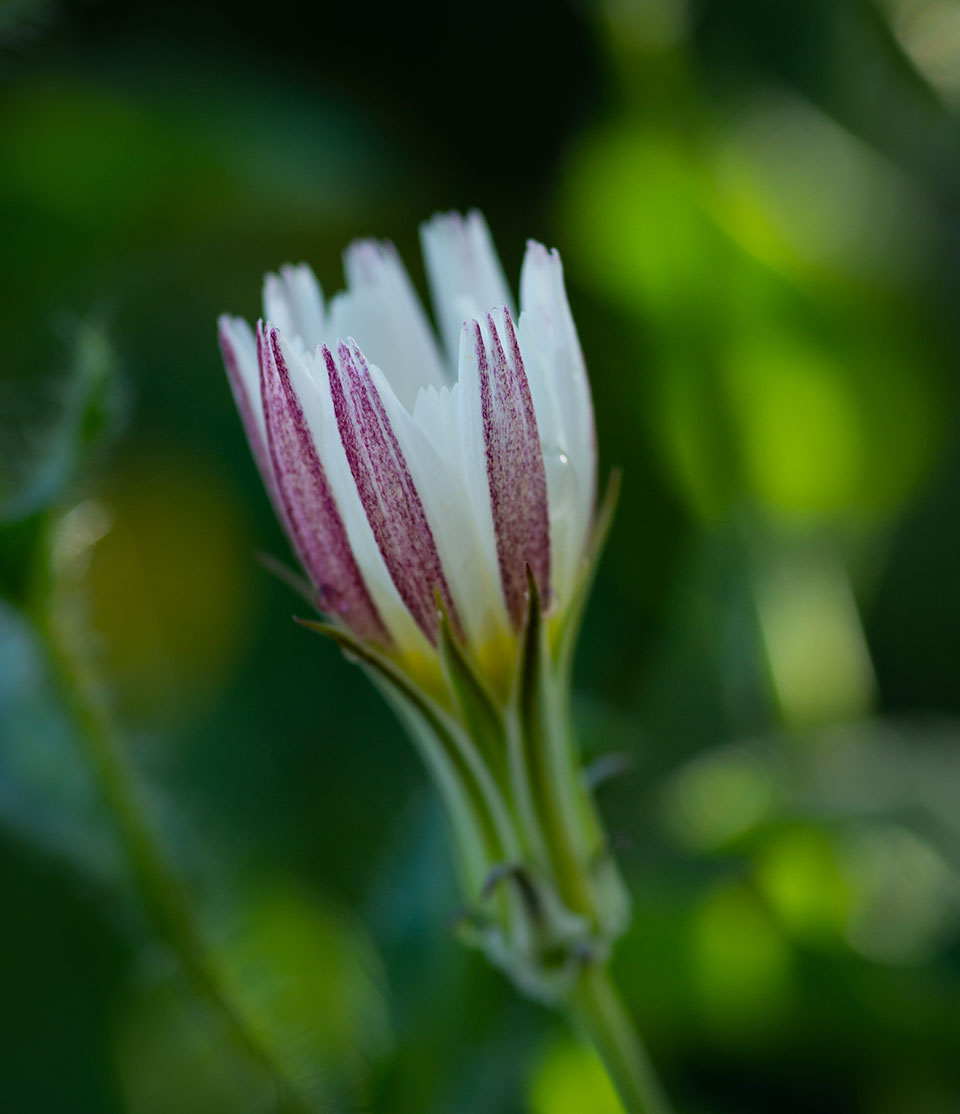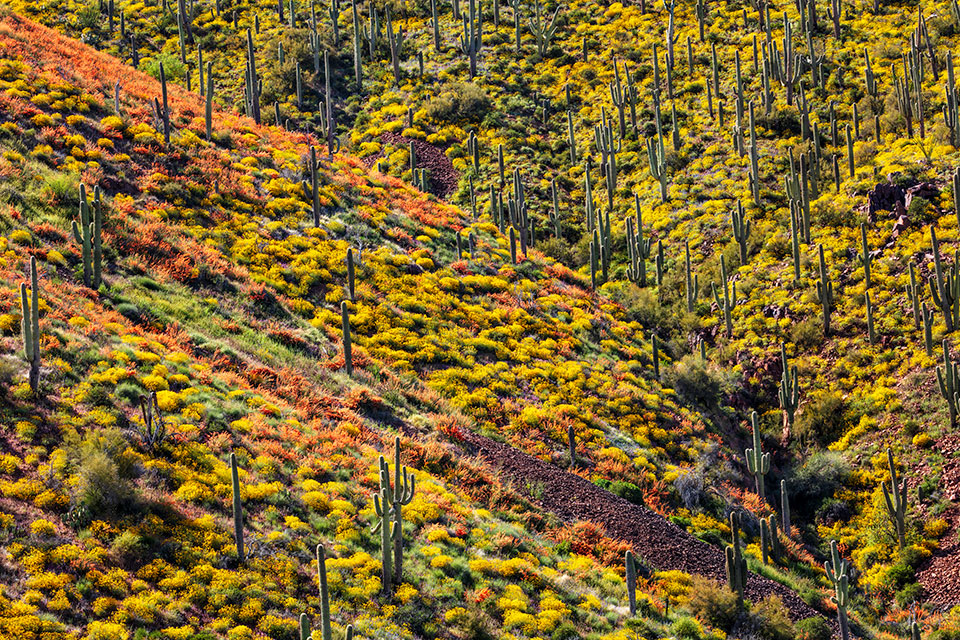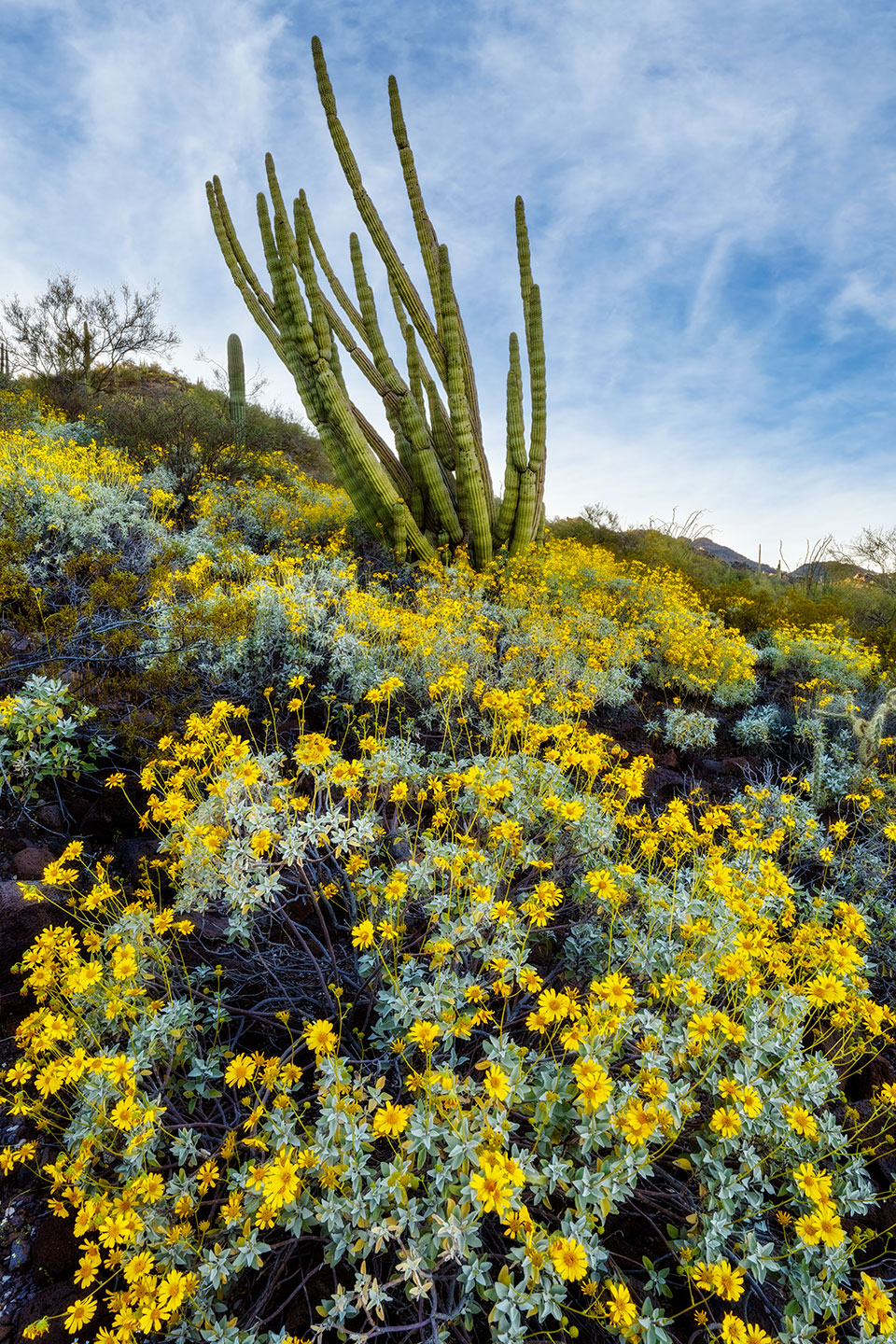
Desert sand verbenas (purple) and evening primroses (white and yellow) blanket a sand dune at Havasu National Wildlife Refuge in Western Arizona. Operated by the U.S. Fish and Wildlife Service, the refuge protects 17,600 acres along the Colorado River in Arizona and California.
Claire Curran
FUJIFILM GFX100S, 1/20 SEC, F/20, ISO 100, 24 MM LENS

A desert chicory bloom greets the rising sun at Picacho Peak State Park. Native to the Sonoran and Mojave deserts, desert chicory grows in sandy or gravelly soil in the American Southwest and parts of northern Mexico.
Gurinder Singh
NIKON D800, 1/320 SEC, F/6.3, ISO 320, 100 MM LENS

Flowering brittlebushes (yellow) and globemallows (orange) surround mature saguaros on a hillside near Theodore Roosevelt Lake, east of the Phoenix area. Both of these desert plants typically bloom in late winter and early spring.
Claire Curran
CANON EOS 5DS R, 1/8 SEC, F/18, ISO 100, 148 MM LENS

Cholla cactuses rise from a sea of Mexican goldpoppies and lupines in the Mount Nutt Wilderness, part of Western Arizona’s Black Mountains. Established in 1990, this 28,000-acre wilderness area protects a carved volcanic landscape that’s a haven for backpackers, rock climbers and photographers.
Jonathan Buford
FUJIFILM GFX 50R, 1/15 SEC, F/29, ISO 250, 23 MM LENS

Delicate globemallow blooms contrast with the spines of a prickly pear cactus at Ironwood Forest National Monument, near Tucson. Starting around early May, prickly pears produce colorful blooms of their own.
Jack Dykinga
FUJIFILM GFX100S, 1/80 SEC, F/8, ISO 400, 120 MM LENS

Purple lupine petals complement the yellow blooms of fiddlenecks in the Florence area, southeast of Phoenix. In the Sonoran Desert, these colorful flowers usually bloom around the same time — between March and May.
Eirini Pajak
CANON EOS R5, 1/800 SEC, F/2.8, ISO 100, 100 MM LENS

Brittlebushes thrive beneath one of the namesakes of Organ Pipe Cactus National Monument in Southern Arizona. The monument’s size (516 square miles) and varied terrain mean wildflower blooms of some kind can be found from February to May.
Guy Schmickle
FUJIFILM GFX100S, 1/75 SEC, F/8, ISO 100, 27 MM LENS

Delicate yellow wildflowers proliferate beneath the Kaiparowits Plateau, a landform on Arizona’s state line with Utah. This particular location is in Glen Canyon National Recreation Area, which straddles the state line.
Jack Dykinga
FUJIFILM GFX100S, 1/25 SEC, F/22, ISO 1250, 120 MM LENS

A lone scorpionweed blooms in the Tonto National Forest, which covers nearly 3 million acres in Central Arizona. Typically found along desert washes and on hillsides, scorpionweed blooms usually appear between February and May.
Colleen Miniuk
OLYMPUS E-M1 MARK II, 1/125 SEC, F/9, ISO 400, 60 MM LENS

Owl’s clover (purple) and creamcups (white) carpet a meadow beneath the Sedona area’s Bear Mountain. Generally, March through May is the best time of year to see wildflowers in Red Rock Country.
Guy Schmickle
NIKON D850, 0.4 SEC, F/11, ISO 64, 31 MM LENS

Globemallows and other flowers — possibly blackfoot daisies — anchor a sunset view of the namesake waterway of the Salt River Canyon Wilderness. This remote, rugged wilderness area has no maintained trails but is known for river running.
Joel Hazelton
CANON EOS 5DS R, 1/6 SEC, F/18, ISO 320, 16 MM LENS

Saguaro cactuses loom over Mexican goldpoppies in a field at Picacho Peak State Park, northwest of Tucson. Perhaps Arizona’s best-known desert wildflower, the Mexican goldpoppy is a subspecies of the California poppy.
Guy Schmickle
FUJIFILM GFX100S, 1/10 SEC, F/11, ISO 100, 22.4 MM LENS

